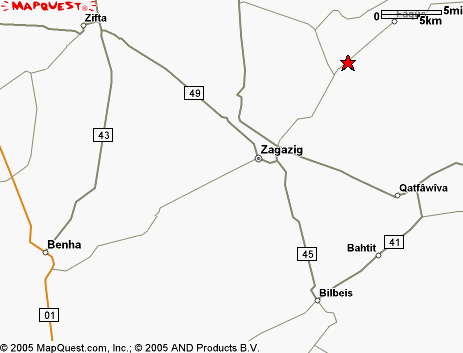El Sakakra السكاكرة is a village about 3 kilometers north east of Hehia ههيا (also Hehya), which is the center (Markaz) to which Shersheima belongs. Hehia is about 15 kilometers north east of El Zaqaziq الزقازيق , the capital of the governorate of El Sharqeyya (Sharkeya or Sharkeyya الشرقية).
In the 1960s, it had only 2,100 people, and by the early 21st century, it has 6,000 to 7,000 people.
Shersheima شرشيمة (or Shershema) is a twin village of El Sakakra, with a drainage canal separating them, which has been filled now.
Map
This is a map of where El Sakakra in relation to Zaqaziq and Benha. Tanta is west of Zifta.

Latitude and Longitude Coordinates
These are as follows:
- Zaqaziq: 30 35' N 31 30' E
- Hehia: 30 39' N 31 35' E
- Shersheima: 30 40' N 31 36' E
- El Sakakra: 30 41' N 31 37' E
Historical Background
The linguistic etymology of the name Sakakra in Arabic seems to be from "Sukkar سكر", which means "sugar". Folklore in the village says that it is derived from a person called El Khawaga Sakaker الخواجة سكاكر who owned a mill in the area long time ago.
The title Khawaga خواجة in Egypt means a non-Muslim foreigner, for example Syrian or Lebanese Christian or Jew. It also applies to Europeans such as Greeks and Italians.
Two families were the original inhabitants of El Sakakra village, my grandfather's family, who came first and settled on the hill in the south west, then the Zaher زاهر family came later and settled in the north east part.
Shersheima's etymology is said to be from two Arabic words, شر and شيمة meaning "worst trait" or "evil habit", since they are said to be descendants from highway robbers.
Shersheima used to be called El Farideyya الفريدية, in honor of Queen Farida (born: Safinaz Zulfikar), who was the first wife of King Farouk I of Egypt. El Farideyya was agricultural land given to the bride as dowry (Mahr). However, since she only gave birth to girls, she was divorced 10 years after the marriage. The village changed the name back to Shersheima, as it is common practice in things named after an important person, who then falls out of favor.
Most of the lands were confiscated after the 1952 revolution, when the king was deposed and all property of the Mohamed Ali dynasty was taken away. However, recently, the daughters of King Farouk have filed for getting back some of the land in Shersheima and El Sakakra, within the limits by the land reform laws, as detailed in this article about the law suit.
قدمت للمحكمة مستندات تثبت أحقية الأميرات في مساحة قدرها خمسون فداناً من أصل 1744 فدان و23 قيراط و13 سهماً طبقاً لقانون الإصلاح الزراعي بموجب حجة وقف رسمية ومشهرة برقم 52 صفحة 15 بالمضبطة المخصصة لوقف الملك فاروق لزوجته فريدة ثم لبناتها فريال وفوزية وفادية من بعدها وتشمل تلك الأراضي المباني والأشجار الكائنة بناحية السكاكرة وشرشيمة مركز ههيا بالشرقية
Famous People
One famous person hailing form Shersheima is Sheikh Abdel Mo'ti El Shersheimi عبد المعطي الشرشيمي who was a Muhaddith محدث (specialist in Hadith and its narration) in Al Azhar University in the first few decades of the 20th century. Of note is his involvement in a report in March 1923 about the fall of the Khilafa. He also participated in a report by Al Azhar condemning Taha Hussein's controversial book, "Fi Al She'r Al Jahili" في الشعر الجاهلي. He taught many people, including Abdul Aziz Al Ghemmari عبد العزيز الغماري from Tangier, Morocco.
Dr. Osama El Shennawy أسامة الشناوي is a famous liver transplant surgeon, from El Sakakra.
One author, Salah Wali صلاح والي, has published a quadrilogy of novels, which is actually a sort of an autobiography, that related childhood memories in El Sakakra.There are lots of objections on his style, delving into sexual themes, and other socially unacceptable areas. Some details are in this article. The first one is called "The Croaking of the Frogs" نقيق الضفادع which is a very common sound in summer nights there. He relates how the village has physcially changed from mud brick adobe type homes to concrete buildings that get higher and higher. Also, he describes the social changes and the political situation in the early days of the 1952 Revolution.
His other novels include الرعية (The Governed).

Comments
Anonymous (not verified)
بلدي ... حلوه يا بلدي
Fri, 2008/12/19 - 21:42معلومات قيمه ... تسلم ايد اللي كتبها